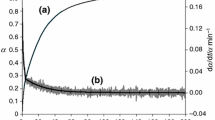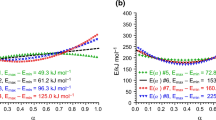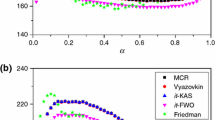Abstract
The influence of the sample weight and the heating rate upon the thermal deamination of [Co(niox · H)2(pyridine)2]I(I), [Co(niox · H)2(aniline)2]I (II) and [Co(niox · H)2 (pyridine)2] NCS · 1.5 H2O (III) and upon the dehydration of (III) has been studied (niox · H2 stands for nioxime: 1,2-cyclohexanedione dioxime). Kinetic parametersn, E andZ have been derived by means of the authors' three computerized integral methods. Analysis of the results shows method 1 to be equivalent to method 2 with respect to the numerical values obtained, but it needs a tenfold computer time. Method 3 gives better results due to the better choice of input data. The influence of the working conditions and of the chemical constitution upon the kinetic parameters, as well as the kinetic compensation effect, are discussed.
Résumé
On a étudié l'influence du poids de l'échantillon et de la vitesse de chauffage sur la désamination thermique de [Co(niox · H)2(pyridine)2]I (I), [Co(niox · H)2(aniline)2]I (II) et [Co(niox · H)2(pyridine)2]NCS · 1.5 H2O (III) ainsi que sur la déshydratation de (III) (niox · · H2 représente la nioxime: 1,2-cyclohexanedione dioxime). A l'aide des trois méthodes d'intégration sur ordinateur des auteurs, les paramètres cinétiquesn, E et Z ont pu Être déduits. L'analyse des résultats montre que la méthode est équivalente à la méthode 2 quant aux valeurs numériques obtenues; elle exige cependant dix fois plus de temps d'ordinateur. La méthode 3 donne de meilleurs résultats en raison de la meilleure sélection des données d'entrée. On discute l'influence des conditions de travail et de la structure chimique sur les paramètres cinétiques ainsi que l'effet de compensation cinétique.
Zusammenfassung
Der Einfluss des Probengewichts und der Aufheizgeschwindigkeit auf die thermische Desaminierung von [Co(niox · H)2(pyridin)2]I (I), [Co(niox · H)2(anilin)2]I (II) und [Co(niox · H)2(pyridin)2]NCS · 1.5 H2O (III) sowie auf die Dehydratisierung von (III) wurde untersucht (niox · H2 bedeutet Nioxim: 1,2-cyclohexandion-dioxim). Die kinetischen Parametern, E undZ wurden mit Hilfe der drei komputerisierten Integralmethoden der Autoren abgeleitet. Die Analyse der Ergebnisse zeigt, da\ Methode 1 der Methode 2 hinsichtlich der erhaltenen numerischen Werte ebenbürtig ist, doch eine zehnfache Rechenzeit beansprucht. Methode 3 ergibt bessere Resultate dank der besseren Wahl der eingegebenen Daten. Der Einfluss der Arbeutsbedingungen und der chemischen Struktur auf die kinetischen Parameter, sowie der kinetische Kompensationseffekt werden diskutiert.
РЕжУМЕ
ИжУЧЕНО ВлИьНИЕ ВЕсА ОБРАжцА И скОРОстИ НАгРЕВА НА тЕРМИЧЕск ОЕ ДЕАМИНИРОВАНИЕ кОМплЕксОВ [сО(НИОкс. Н)2 (пИРИДИНУ I (I), [сО(НИОкс. Н)2 (АНИлИН)2] I (II) И [Co(НИОкс.Н)2 (пИРИДИНУ NCS. 1.5 H2O (III), гДЕ (НИОк с.Н)2 — НИОксИМ: ДИОксИМ 1.2-цИклОгЕксАНДИОНА. Дль пОслЕДНЕгО Иж УкА жАННых сОЕДИНЕНИИ Иж УЧЕНА тАкжЕ ДЕгИДРАтАцИь. с пОМОЩ ьУ тРЕх ИНтЕгРАльНых, Вы ЧИслИтЕльНых МЕтОДО В, пРЕДлОжЕННых АВтОРА МИ, ВыЧИслЕНы кИНЕтИЧЕскИЕ пАРАМЕ тРып, EИ.Z. АНАлИж РЕжУл ьтАтОВ пОкАжАл, ЧтО МЕтОД 1 ЁкВ ИВАлЕНтНыИ МЕтОДУ 2 В ОтНОшЕНИИ пО лУЧЕННых ЧИслОВых жН АЧЕНИИ, НО тРЕБУЕт В ДЕсьть РАж Б ОльшЕ МАшИННОгО ВРЕМЕНИ. МЕ тОД 3 ДАЕт лУЧшИЕ РЕжУл ьтАты, ЧтО ОБУслОВлЕНО лУЧшИМ п ОДБОРОМ ВВОДНых ДАННых. ОБсУж ДЕНО ВлИьНИЕ ЁкспЕРИ МЕНтАльНых УслОВИИ И хИМИЧЕскОг О сОстАВА сОЕДИНЕНИИ НА кИНЕтИ ЧЕскИЕ пАРАМЕтРы, сОВ МЕстНО с кИНЕтИЧЕскИМ кОМпЕН сАцИОННыМ ЁФФЕктОМ.
Similar content being viewed by others
References
J. Zsakó andM. Lungu, J. Thermal Anal., 5 (1973) 77 and references therein.
J. Zsakó, Cs. Várhelyi andG. Liptay, Thermal Analysis. Proc. 4th ICTA, Budapest, 1974, vol. I. p. 825.
J. Zsakó andJ. Zsakó jr., J. Thermal Anal., 19 (1980) 333.
R. C. Turner, J. Hoffmann andD. Chen, Can. J. Chem., 41 (1963) 243.
I. C. Hisatsune, E. C. Beahm andR. J. Kempf, J. Phys. Chem., 74 (1970) 3444.
D. Furnica andJ. A. Schneider, Makromol. Chem., 108 (1967) 182.
J. A. Schneider, Makromol. Chem., 125 (1969) 201.
J. Zsakó, E. Kékedy andCs. Várhelyi, Thermal Analysis. Proc. 3rd ICTA, Davos, 1971. Vol. 2, p. 487; Thermal Analysis. Proc. 4th ICTA, Budapest, 1974 Vol. I., p. 177.
J. Zsakó, M. Várhelyi andCs. Vàrhelyi, J. Thermal Anal., 17 (1979) 123.
J. Zsakó, J. Thermal Anal., 15 (1979) 369.
J. Zsakó, J. Thermal Anal., 9 (1976) 101 and references therein.
J. Zsakó, E. Brandt-Petrik, G. Liptay andCs. Várhelyi, J. Thermal Anal., 12 (1977) 421.
J. Zsakó, Cs. VÄrhelyi, G. Liptay andK. Szilàgyi, J. Thermal Anal., 7 (1975) 41.
P. D. Garn, J. Thermal Anal., 10 (1976) 99.
L. Erdey andF. Paulik, Magy. Tud. Akad. Kém. Tud. Oszt. Közl., 5 (1955) 461; L.Kékedy, P.Kröbl, A.Szurkos and E.Kékedy, Studia Univ. Babes-Bolyai, Chem., 3 (1958) 99.
Author information
Authors and Affiliations
Rights and permissions
About this article
Cite this article
Zsakó, J., Horák, J. & Várhelyi, C. Kinetic analysis of thermogravimetric data XVI. Journal of Thermal Analysis 20, 435–445 (1981). https://doi.org/10.1007/BF01912892
Received:
Issue Date:
DOI: https://doi.org/10.1007/BF01912892




